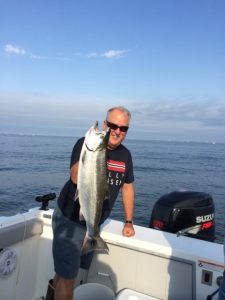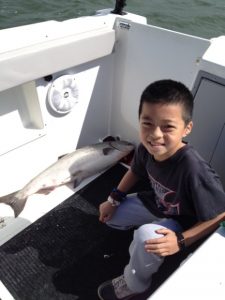Buoy 10 salmon fishery opens Aug. 1, and don’t expect solitude at highly popular late-summer destination Leave a reply
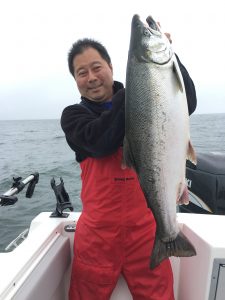
While king salmon garner most of the attention at Buoy 10 look for some huge coho like this one hooked last August.
By Mark Yuasa
Year in and year out, the Lower Columbia River mouth near Buoy 10 has been deemed one of the top salmon fisheries in the Pacific Northwest and anglers will see an added caveat in later-summer.
Tony Floor, the director of fishing affairs for the Northwest Marine Trade Association has made this is second home in late-summer since the mid-1980s, and indicates Buoy 10 usually produces decent action right when it opens.
State Fish and Wildlife says the projected catches at Buoy 10 will be around 22,100 chinook and 16,560 coho (including 1,500 release mortalities).
“I think realistically its tougher to predict this season and the best data is the forecast, which can be debated,” Floor said. “I believe them and have used them for 45 years, and the number this season is significantly down by 35 to 45 percent. The reality button is people should show patience.”
The good news is anglers will be allowed to keep wild and/or hatchery chinook daily, unlike last year when wild chinook needed to be released on Sundays and Mondays. During those two days last summer there was a big drop in effort as not many of the kings are hatchery-marked fish.
The fishing season will get underway on Aug. 1 through Labor Day (Sept. 4) with a daily limit of two salmon, and only one of which can be a chinook. The daily limit at Buoy 10 from Sept. 5 through 30 will be two hatchery coho, but all chinook must be released.
From Oct. 1 through Dec. 31, the Buoy 10 rules allow anglers to keep two adult salmon daily, but coho must be hatchery-marked.
In-season considerations include a potential for allowing a chinook mark-selective fishery during all or part of the non-retention season from Sept. 5-30.
The red navigational buoy – known as Buoy 10 – is located just south of the Port of Ilwaco which marks the western boundary of this nearly 20-mile fishing area that heads east upstream to the Tongue Point-Rocky Point boundary above the Astoria-Megler Bridge.
Just like last year, if you haven’t already booked moorage space don’t expect to any spaces as the Port of Ilwaco has filled their allotment in August. Anglers will still be able to get their boats in the water at various boat ramps, but be patient and expect long waiting times at the ramps.
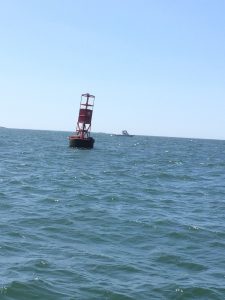
The red navigational marker known as “Buoy 10” is a place many anglers flock to, but there are many other areas to fish at the Lower Columbia River mouth.
A Columbia River fall chinook forecast of 582,600 closely mirrors last year’s actual return (951,300 was forecast last year with an actual return of 643,300), and was the fourth largest on record but down significantly from the record runs in 2013 to 2015.
The all-time actual return record dating to 1938 was 1,268,400 adult chinook in 2013, which was 227 percent of the 2003-to-2012 average of 557,600 adult fish. In 2014, the actual return was 1,159,000, which was second-highest on record.
“We saw some of the biggest runs of the century (in 2013-2015), and now it has fallen down due to ocean conditions, El Nino and the blob,” Floor said. “But, despite all the rhetoric it is still a good choice, and the best timeframe will be the third week of August.”
The Columbia River coho forecast calls for 496,200 to arrive off the Washington-Oregon coast, compared to a preseason forecast of 549,200 last year and an actual return of 317,000.
That is a stark difference in comparison to a forecast of 1,015,000 in 2015 and an actual return of 322,100 and a forecast in 2014 of 964,100 with a return of 1,240,800.
The Columbia subtotal this season is 386,300 (380,600 last year and 223,100 actual return) – these are fish that turn the corner of southwest Washington and into the “Big-C” and doesn’t include the northern Oregon coast.
The Columbia forecast last year was 777,100 coho, but less than a third actually returned – 242,300. Poor ocean conditions and a lack of feed could have played a negative role.
The gear at Buoy 10 is fairly simplistic and consists of a weighted diver with a KoneZone- or Fish-Flash-type flasher tied to a leader with a whole or cut-plug herring in 30 feet of water.
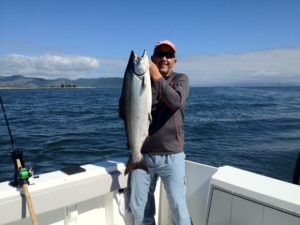
Clyde McBrayer of Olympia hoists a beautiful king salmon caught just below the Astoria-Megler Bridge.
Anglers will need to constantly check their herring as it will get tattered while being dragged along the sandy bottom or from the extremely strong tides. Spinners like a Toman’s Thumper Flex with a blade in red/white or chartreuse attached to a plastic squid or a Brad’s Super Bait Cut Plug lure.
In the early morning on a flood tide, plan to first stop along the Wing Walls – located outside of the Port of Ilwaco – and work your way up and down the river.
The Desdemona Sands (a flat sandy bar which is exposed at low tides) is a place to look at during a mid- to late-flood tide as fish move along the drop-offs. Many will also work the buoy line on the Oregon side up to the bridge, which has also become a very popular area.
Fish either above or below the Astoria-Megler Bridge during flood tide change because that is where the kings tend to hang as they get pushed in with the tide. Others will concentrate at the Church Hole off Fort Columbia State Park; and the northern tip of Fort Stevens State Park on the Oregon side west toward Hammond.
A newly discovered location this summer has been the channel leading out of the Port of Ilwaco marina where anglers were scoring on “dip-in” salmon.
The area is very diverse so if the bite is off at the mouth of the river, many will head out into the ocean along the 30-foot line just outside the surf off Long Beach near the Cape Disappointment Lighthouse. This is a relatively easy place to fish when ocean conditions allow with anglers letting out 13 to 15 pulls of line (two feet per pull) with a diver or Fish Flash and a whole or cut-plug herring.
The best time off Long Beach is August as salmon stage before moving into the Columbia River, and it doesn’t matter on the tide or time of day as long as the fish are holding. On the surf line look on your depth-finder for huge anchovy baitfish schools.
If the batfish aren’t holding off Long Beach, then another option is the the ocean fishing grounds about 7 to 10 miles to areas west of the CR Buoy at depths of 50 to 80 feet, and ofen-times the Ilwaco charter boat fleet will venture even further to the 300-foot depth line.
Oregon Fish and Wildlife data from last season taken between Aug. 1 and Oct. 2 showed 5,018 boats with 15,701 kept 3,004 chinook (plus 1,332 released), 1,478 hatchery coho (plus 763 coho released) and 12 steelhead (plus two steelhead reelased) for 0.19 chinook per rod average and 0.09 on coho and 0.29 for both species.
The week-by-week catch per rod average was 0.11 for Aug. 1-7; 0.20 for Aug. 8-14; 0.22 for Aug. 15-21; 0.41 for Aug. 22-28; 0.50 for Aug. 29-Sept. 4; 0.48 for Sept. 6-11; 0.17 for Sept. 12-18; 0.13 for Sept. 19-25; and 0.16 for Sept. 26-Oct. 2.
Catches abound outside Buoy 10
The Rocky Point-Tongue Point line to the Lewis River/Warrior Rock line is open from Aug. 1 through Sept. 7 for chinook catch-and-keep, and then only hatchery-marked chinook may be kept from Sept. 8-14. Daily limit is two adult fish, and only one may be a chinook. Chinook retention will reopen Oct. 1 with a two fish daily limit of which two may be chinook.
The Lewis River/Warrior Rock line to Bonneville Dam will be open for chinook from this Aug. 1 through Dec. 31. The daily limit is two adult salmon of which two may be chinook.
In those two areas, state fisheries expect a catch (including release mortality) of 21,890 adult chinook (33,620 last year) and 1,040 adult coho (1,570 last year).
Areas from Bonneville Dam to the Highway 395 Bridge in Pasco will be open Aug. 1 through Dec. 31 with a daily limit of two adult salmon. The catch expectation is 4,080 adult chinook.
Anglers on the boat may keep fishing until the catch limit is achieved for all aboard from Buoy 10 up to the Oregon/Washington border.
Shore fishing is option at Buoy 10
Both sides at the Lower Columbia River mouth have good shoreline fishing options where anglers can have a decent chance to catch a salmon.
The North Jetty on the Washington side is open daily when the marine area off Ilwaco or Buoy 10 areas are open for salmon. The daily limit and minimum size restrictions follow the most liberal of either of these areas. A saltwater or combination license is required to fish from the North Jetty.
On the Oregon side, anglers on an incoming tide can cast from long sandy stretch of beach-line along Clatsop Spit west of Hammond in the State Park. Most will cast a Blue Fox or Mepps spinner attached to a 30-inch leader with a one ounce banana weight to run it off the bottom. Other will use a number 5 or 6 bell-body red or orange lure with a small Nickle-blade dodger.
Willapa Bay another worthwhile destination
Buoy 10 isn’t the only later-summer option to catch salmon, and just north is Willapa Bay near Tokeland and from the towns of Raymond down to South Bend along Highway 101.
Not only does the Willapa River system host a good number of chinook, but the Columbia River chinook tend to dip-in at Washaway Beach.
The Willapa system itself is expecting a good run of 32,674 (36,200 was forecast last year) hatchery kings for a total run of 36,805, and has seen an increased hatchery production with boosted runs since 1988. This shallow water fishery will be good from August and peaks usually around Labor Day weekend. has seen an increased hatchery production with boosted runs since 1988.
More than a decade ago, the best fishing occurred along the shallow surf line at Washaway Beach on the outer perimeter of Cape Shoalwater, which is the major migration highway for salmon.
Now the fishery has shifted inside the bay’s deep channel and is dotted with red and green channel markers numbered from 2 to 27. The markers start in the middle of the bay and run all the way to the Willapa River mouth, and it is here where the salmon park before heading into the Willapa River salmon hatchery and some to the spawning grounds.
The preferred technique is to slowly troll in water 10 to 25 feet deep using a 6-ounce drop sinker ball on a three-way sliding swivel attached to a chartreuse green Kone Zone flasher and a 6-foot leader laced with a cut-plug herring.
Be sure to keep your bait about 1-2 feet off the bottom, smack dab in front of the fish’s face.
Salmon move in and out of the bay to feed on baitfish pushed in by the tides. Stay away from big tidal flows as grass that gets pushed into the bay can make it virtually impossible to keep off you gear.


